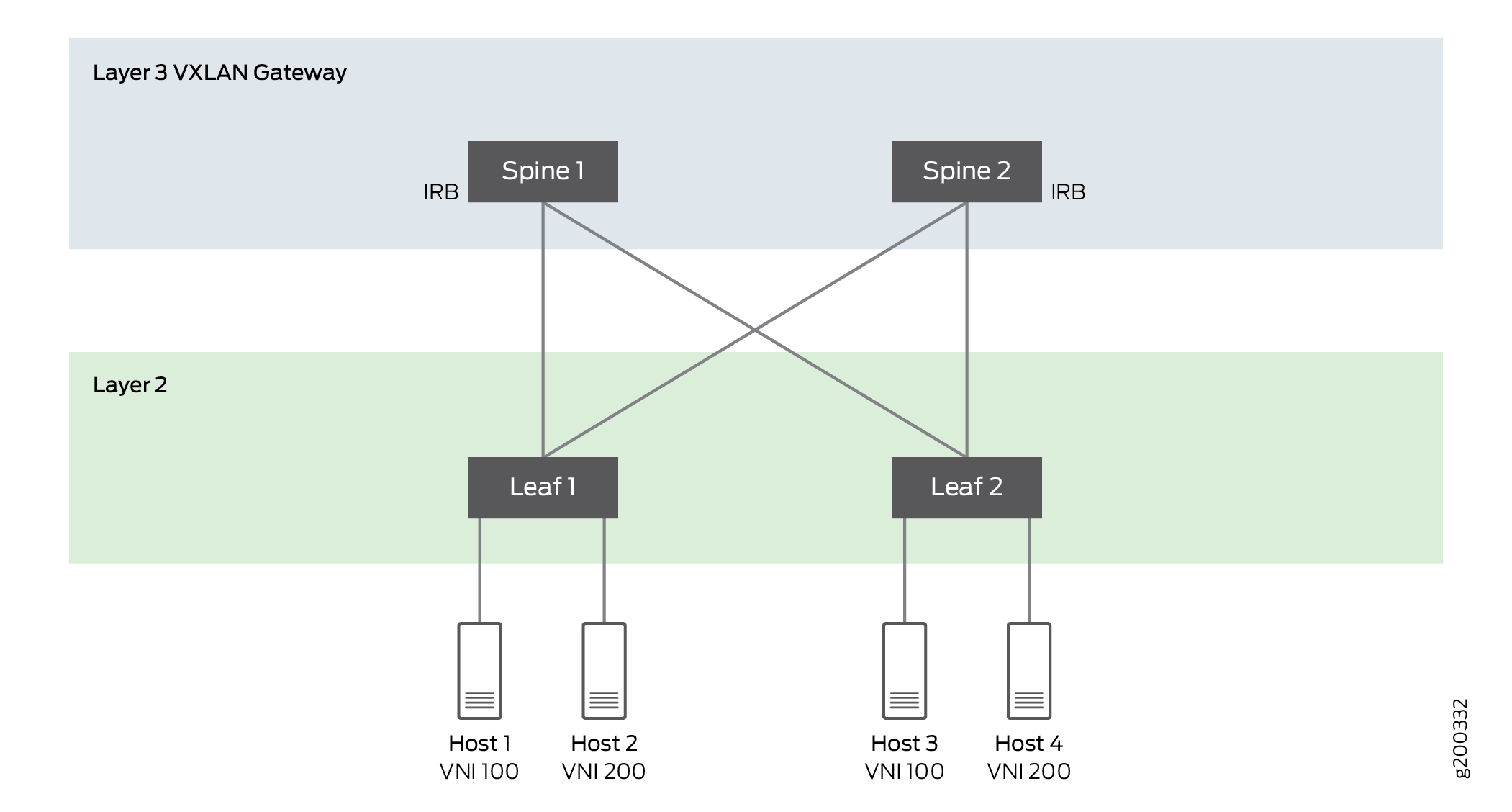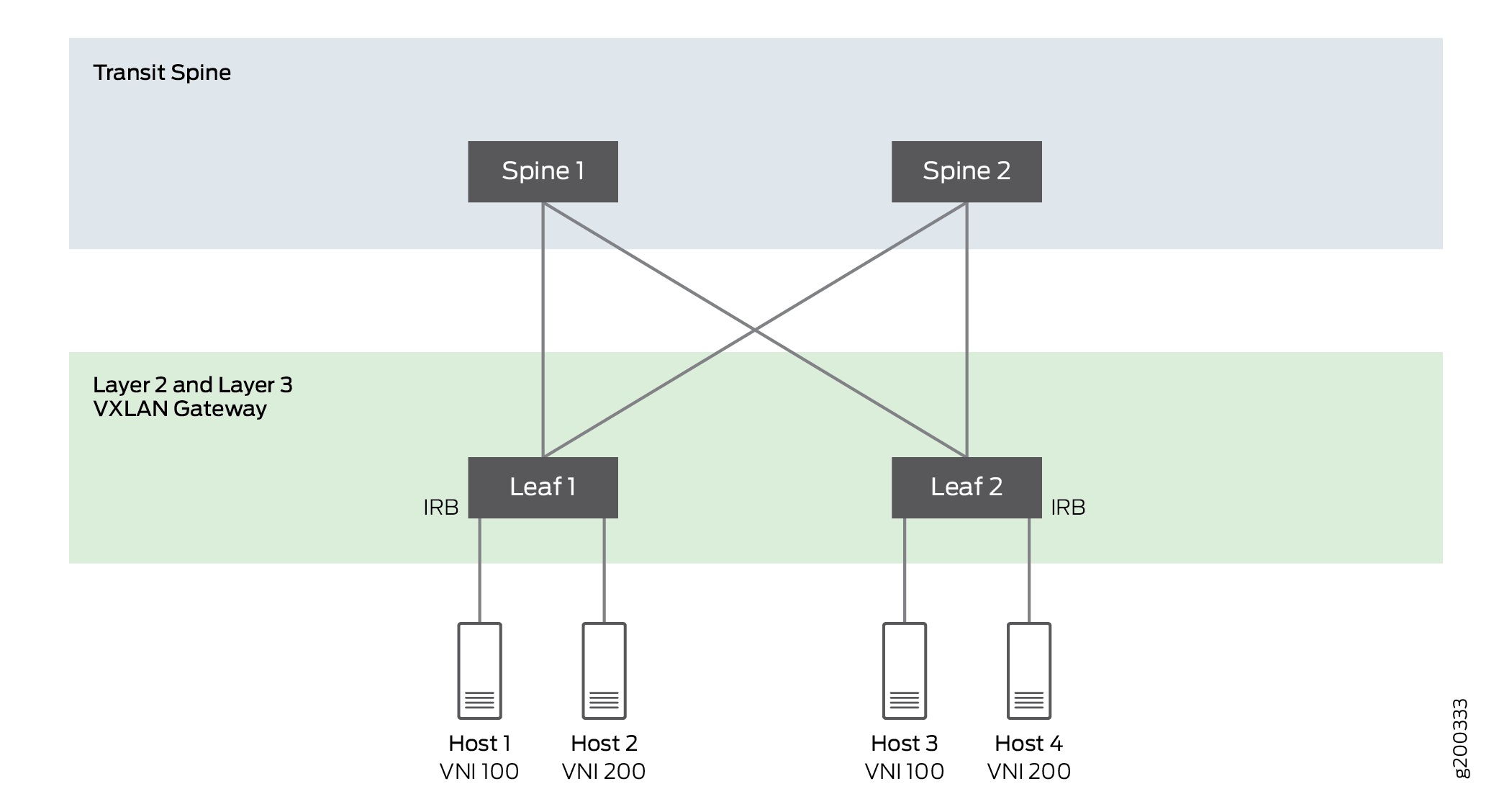- play_arrow Features Common to EVPN-VXLAN, EVPN-MPLS, and EVPN-VPWS
- play_arrow Configuring Interfaces
- play_arrow MAC Address Features with EVPN Networks
- play_arrow Configuring Routing Instances for EVPN
- Configuring EVPN Routing Instances
- Configuring EVPN Routing Instances on EX9200 Switches
- MAC-VRF Routing Instance Type Overview
- EVPN Type 5 Route with VXLAN Encapsulation for EVPN-VXLAN
- EVPN Type 5 Route with MPLS encapsulation for EVPN-MPLS
- Understanding EVPN Pure Type 5 Routes
- Seamless VXLAN Stitching with Symmetric EVPN Type 2 Routes using Data Center Interconnect
- Symmetric Integrated Routing and Bridging with EVPN Type 2 Routes in EVPN-VXLAN Fabrics
- EVPN Type 2 and Type 5 Route Coexistence with EVPN-VXLAN
- Ingress Virtual Machine Traffic Optimization
- Tracing EVPN Traffic and Operations
- Migrating From BGP VPLS to EVPN Overview
- Configuring EVPN over Transport Class Tunnels
- Example: Configuring EVPN-VPWS over Transport Class Tunnels
- play_arrow Configuring Route Targets
- play_arrow Routing Policies for EVPN
- play_arrow Layer 3 Gateways with Integrated Routing and Bridging for EVPN Overlays
- play_arrow EVPN Multihoming
- EVPN Multihoming Overview
- EVPN Multihoming Designated Forwarder Election
- Understanding Automatically Generated ESIs in EVPN Networks
- Easy EVPN LAG (EZ-LAG) Configuration
- Configuring EVPN Active-Standby Multihoming to a Single PE Device
- Configuring EVPN-MPLS Active-Standby Multihoming
- Example: Configuring Basic EVPN-MPLS Active-Standby Multihoming
- Example: Configuring EVPN-MPLS Active-Standby Multihoming
- Example: Configuring Basic EVPN Active-Active Multihoming
- Example: Configuring EVPN Active-Active Multihoming
- Example: Configuring LACP for EVPN Active-Active Multihoming
- Example: Configuring LACP for EVPN VXLAN Active-Active Multihoming
- Example: Configuring an ESI on a Logical Interface With EVPN-MPLS Multihoming
- Configuring Dynamic List Next Hop
- play_arrow Link States and Network Isolation Conditions in EVPN Networks
- play_arrow EVPN Proxy ARP and ARP Suppression, and NDP and NDP Suppression
- play_arrow Configuring DHCP Relay Agents
- play_arrow High Availability in EVPN
- play_arrow Monitoring EVPN Networks
- play_arrow Layer 2 Control Protocol Transparency
-
- play_arrow EVPN-MPLS
- play_arrow Overview
- play_arrow Convergence in an EVPN MPLS Network
- play_arrow Pseudowire Termination at an EVPN
- play_arrow Configuring the Distribution of Routes
- Configuring an IGP on the PE and P Routers on EX9200 Switches
- Configuring IBGP Sessions Between PE Routers in VPNs on EX9200 Switches
- Configuring a Signaling Protocol and LSPs for VPNs on EX9200 Switches
- Configuring Entropy Labels
- Configuring Control Word for EVPN-MPLS
- Understanding P2MPs LSP for the EVPN Inclusive Provider Tunnel
- Configuring Bud Node Support
- play_arrow Configuring VLAN Services and Virtual Switch Support
- play_arrow Configuring Integrated Bridging and Routing
- EVPN with IRB Solution Overview
- An EVPN with IRB Solution on EX9200 Switches Overview
- Anycast Gateways
- Configuring EVPN with IRB Solution
- Configuring an EVPN with IRB Solution on EX9200 Switches
- Example: Configuring EVPN with IRB Solution
- Example: Configuring an EVPN with IRB Solution on EX9200 Switches
- play_arrow Configuring IGMP or MLD Snooping with EVPN-MPLS
-
- play_arrow EVPN E-LAN Services
- play_arrow EVPN-VPWS
- play_arrow Configuring VPWS Service with EVPN Mechanisms
- Overview of VPWS with EVPN Signaling Mechanisms
- Control word for EVPN-VPWS
- Overview of Flexible Cross-Connect Support on VPWS with EVPN
- Overview of Headend Termination for EVPN VPWS for Business Services
- Configuring VPWS with EVPN Signaling Mechanisms
- Example: Configuring VPWS with EVPN Signaling Mechanisms
- FAT Flow Labels in EVPN-VPWS Routing Instances
- Configuring EVPN-VPWS over SRv6
- Configuring Micro-SIDs in EVPN-VPWS
-
- play_arrow EVPN-ETREE
- play_arrow Overview
- play_arrow Configuring EVPN-ETREE
-
- play_arrow Using EVPN for Interconnection
- play_arrow Interconnecting VXLAN Data Centers With EVPN
- play_arrow Interconnecting EVPN-VXLAN Data Centers Through an EVPN-MPLS WAN
- play_arrow Extending a Junos Fusion Enterprise Using EVPN-MPLS
-
- play_arrow PBB-EVPN
- play_arrow Configuring PBB-EVPN Integration
- play_arrow Configuring MAC Pinning for PBB-EVPNs
-
- play_arrow EVPN Standards
- play_arrow Supported EVPN Standards
-
- play_arrow VXLAN-Only Features
- play_arrow Flexible VXLAN Tunnels
- play_arrow Static VXLAN
-
- play_arrow Configuration Statements and Operational Commands
Supported Protocols on an IRB Interface in EVPN-VXLAN
EVPN-VXLAN provides logical layer 2 connectivity over a layer 3 network. It is a logical overlay that is decoupled from the underlay network. The layer 2 subnets in the EVPN-VXLAN network are uniquely identified by the virtual network identifier (VNI) where devices configured with the same VNI are considered to be in the same logical subnet. The devices in the same logical subnet can communicate directly with each other when they are connected to the same virtural gateway. To route traffic when devices with different VNIs are connected to the same gateway, you must configure an IRB interface on the VXLAN gateway to route traffic. This allows protocol adjacencies to be established between the layer 3 gateway IRB interface and customer edge devices in the following scenarios:
Support networking functions when there are firewalls or load balancers connected between the host and the gateway device.
Support inter-VNI routing when VNIs for the same tenant extend across data centers.
Figure 1 illustrates a simple leaf-spine (centrally-routed bridging overlay) topology in an EVPN-VXLAN network with the VXLAN gateway on spine devices. For host 1 to communicate with hosts in other VNIs, you must configure the IRB interfaces on the VXLAN gateway on the spine devices.
When configuring an ESI interface for multihomed devices, Junos OS only supports routing protocols that are configured on an IRB in the all-active multihoming mode in a centrally-routed bridging overlay EVPN-VXLAN network.

Figure 2 illustrates a collapsed leaf-spine (edge-routed bridging) topology with VXLAN gateways on leaf devices. For host 1 to communicate with hosts in other VNIs, you must configure IRB interfaces on the VXLAN gateway on the leaf devices.

Junos OS supports the following protocols on the IRB in the EVPN-VXLAN overlay network:
OSPF
IS-IS
BGP (eBGP and iBGP)
Bidirectional forwarding detection (BFD) support for ISIS, OSPF, BGP and static routing.




















